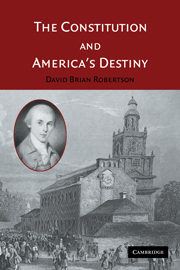Book contents
- Frontmatter
- Contents
- List of Tables and Figures
- Preface
- Acknowledgments
- List of Abbreviations
- 1 Politics and the Constitution
- 2 The Policy Crisis of the 1780s
- 3 James Madison's Plan for the Constitutional Convention
- 4 The Political Landscape of the Constitutional Convention
- 5 Who Governs? Constituting Policy Agency
- 6 What Can Be Governed? Constituting Policy Authority
- 7 How Is the Nation Governed? Constituting the Policy Process
- 8 Our Inheritance: The Constitution and American Politics
- Index
5 - Who Governs? Constituting Policy Agency
Constituting Policy Agency
Published online by Cambridge University Press: 11 November 2009
- Frontmatter
- Contents
- List of Tables and Figures
- Preface
- Acknowledgments
- List of Abbreviations
- 1 Politics and the Constitution
- 2 The Policy Crisis of the 1780s
- 3 James Madison's Plan for the Constitutional Convention
- 4 The Political Landscape of the Constitutional Convention
- 5 Who Governs? Constituting Policy Agency
- 6 What Can Be Governed? Constituting Policy Authority
- 7 How Is the Nation Governed? Constituting the Policy Process
- 8 Our Inheritance: The Constitution and American Politics
- Index
Summary
No issue tore at the Constitutional Convention more than the problem of choosing and controlling those who would govern. Virginia's plan directly challenged the equal state representation already established in the Confederation Congress. Madison and his allies insisted that the states' relative size, not their equal status as states, should determine their relative influence in national policy making. He also sought to eradicate as much state government influence over policy makers as possible. Madison's bold challenge to their existing political defenses galvanized the delegates from the vulnerable middle and northern states. Their delegates united to defend their states' influence in national policy decisions.
The issue of proportional representation in Congress dominated the convention's first month and a half. Sherman and his allies stopped the momentum of Madison's plan, cast his central premises in doubt, refocused the terms of the debate on material interests, and chipped away at his support. Once the delegates accepted the political compromise providing equal state representation in the Senate and proportional representation in the House of Representatives in mid-July, the struggle over policy agency shifted to other agency choices. Madison battled vigorously to give the president the independence to pursue future national interests, and fought to limit the powers of the Senate, now seen as the agent of state governments. Ultimately, the selection of the president was settled by another political compromise on presidential election and power.
- Type
- Chapter
- Information
- The Constitution and America's Destiny , pp. 131 - 164Publisher: Cambridge University PressPrint publication year: 2005



